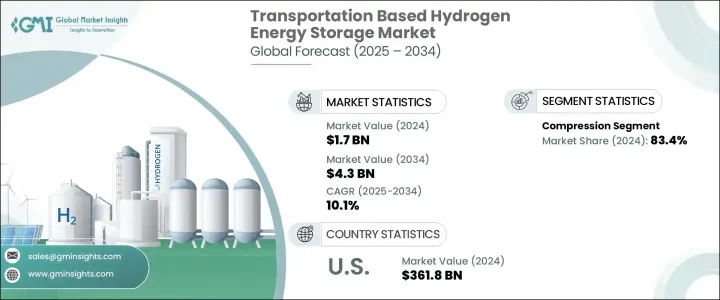
|
市場調査レポート
商品コード
1716462
輸送ベース水素エネルギー貯蔵市場の機会、成長促進要因、産業動向分析、2025年~2034年の予測Transportation Based Hydrogen Energy Storage Market Opportunity, Growth Drivers, Industry Trend Analysis, and Forecast 2025 - 2034 |
||||||
カスタマイズ可能
|
|||||||
| 輸送ベース水素エネルギー貯蔵市場の機会、成長促進要因、産業動向分析、2025年~2034年の予測 |
|
出版日: 2025年03月31日
発行: Global Market Insights Inc.
ページ情報: 英文 155 Pages
納期: 2~3営業日
|
全表示
- 概要
- 目次
世界の輸送ベース水素エネルギー貯蔵市場は、2024年に17億米ドルと推定され、水素貯蔵技術の進歩により、2025年から2034年にかけてCAGR 10.1%で成長すると予測されています。
金属水素化物、高圧タンク、液体水素貯蔵ソリューションの採用増加により、システムの効率、安全性、性能が向上しています。水素ベースのエネルギー貯蔵は、トラック、列車、飛行機を含む長距離電気自動車の持続可能な代替手段として支持を集めています。特に新興経済圏における電気自動車の販売台数の増加が、水素貯蔵ソリューションの需要拡大に寄与しており、さらにグリーン・エネルギーの導入を支持する政府の奨励策や政策も後押ししています。

水素燃料電池は、その高いエネルギー密度、軽量特性、長寿命により、バッテリー式電気自動車で好まれる選択肢になりつつあります。燃料電池技術の絶え間ない革新は、エネルギー効率の限界を押し広げ、水素貯蔵を将来の持続可能な輸送における重要な要素として位置づけています。世界各国の政府は、二酸化炭素排出量を削減するため、特に輸送分野で水素エネルギー貯蔵を積極的に推進しています。観光客の増加や旅行回数の増加も、飛行機や大型トラックなどの長距離輸送車向けの効率的なエネルギー貯蔵ソリューションの需要を後押ししています。
| 市場範囲 | |
|---|---|
| 開始年 | 2024 |
| 予測年 | 2025-2034 |
| 開始金額 | 17億米ドル |
| 予測金額 | 43億米ドル |
| CAGR | 10.1% |
輸送ベース水素エネルギー貯蔵市場は、方法別に圧縮、液化、材料ベースの貯蔵に区分されます。2024年の市場シェアは圧縮方式が83.4%を占め、圧倒的です。長期間エネルギーを貯蔵できることから、水素貯蔵は再生可能エネルギー源や系統エネルギー貯蔵との統合も検討されています。世界各国は、こうした取り組みを支援するために、有利な政策や大規模なエネルギー・プロジェクトを実施しています。再生可能エネルギー統合に広く利用されている揚水発電は、水素ベースのエネルギー貯蔵アプリケーションの拡大に重要な役割を果たしています。
世界の電気自動車販売台数の増加は、クリーンエネルギー自動車の採用が着実に進む中、水素燃料電池の需要を加速させています。欧州、北米、アジア太平洋では、各国が脱炭素化への取り組みを優先しているため、市場は堅調な拡大を見せています。太陽エネルギー分野も著しい成長を遂げており、設置容量は2025年末までに2TWを超えると予想されています。この太陽光発電への移行は、輸送分野における水素燃料電池の旺盛な需要を生み出すと予測されます。
都市化、産業の拡大、老朽化した送電網の近代化が、輸送ベース水素エネルギー貯蔵の需要をさらに高めています。各国政府は、持続可能なエネルギー・ソリューションを推進するため、水素ハブ、再生可能エネルギー貯蔵プロジェクト、大規模インフラ整備に投資しています。
米国では、輸送ベース水素エネルギー貯蔵市場は2022年に3億510万米ドル、2023年に3億3,190万米ドル、2024年に3億6,180万米ドルに達しました。エネルギー貯蔵技術への戦略的投資が今後の市場成長を牽引すると予想されます。中国やインドなどの新興国も、費用対効果の高いエネルギー貯蔵システムの採用を加速させており、アジア太平洋地域の需要を押し上げています。
目次
第1章 調査手法と調査範囲
第2章 エグゼクティブサマリー
第3章 業界洞察
- 業界エコシステム
- 規制状況
- 業界への影響要因
- 促進要因
- 業界の潜在的リスク&課題
- 成長可能性分析
- ポーター分析
- PESTEL分析
第4章 競合情勢
- イントロダクション
- 戦略ダッシュボード
- イノベーションと持続可能性の展望
第5章 市場規模・予測:製品別、2021年~2034年
- 主要動向
- 圧縮
- 液化
- 材料ベース
第6章 市場規模・予測:地域別、2021年~2034年
- 主要動向
- 北米
- 米国
- カナダ
- メキシコ
- 欧州
- ドイツ
- 英国
- フランス
- イタリア
- オランダ
- ロシア
- アジア太平洋
- 中国
- インド
- 日本
- 世界のその他の地域
第7章 企業プロファイル
- Air Liquide
- Air Products and Chemicals
- Cockerill Jingli Compressed hydrogen
- ENGIE
- FuelCell Energy
- GKN Compressed Hydrogen
- Gravitricity
- ITM Power
- Linde plc
- McPhy Energy
- Nel
- SSE
The Global Transportation Based Hydrogen Energy Storage Market was estimated at USD 1.7 billion in 2024 and is projected to grow at a CAGR of 10.1% from 2025 to 2034, driven by advancements in hydrogen storage technology. The increasing adoption of metal hydrides, high-pressure tanks, and liquid hydrogen storage solutions enhances system efficiency, safety, and performance. Hydrogen-based energy storage is gaining traction as a sustainable alternative for long-range electric vehicles, including trucks, trains, and airplanes. The rise in electric vehicle sales, particularly in emerging economies, contributes to the growing demand for hydrogen storage solutions, further supported by government incentives and policies favoring green energy adoption.

Hydrogen fuel cells are becoming a preferred choice in battery electric vehicles due to their high energy density, lightweight properties, and extended lifespan. Continuous innovations in fuel cell technology are pushing the boundaries of energy efficiency, positioning hydrogen storage as a key component in the future of sustainable transportation. Governments worldwide are actively promoting hydrogen energy storage, particularly in the transportation sector, to reduce carbon emissions. Increasing tourism and rising travel frequency are also fueling the demand for efficient energy storage solutions for long-haul vehicles, including planes and heavy-duty trucks.
| Market Scope | |
|---|---|
| Start Year | 2024 |
| Forecast Year | 2025-2034 |
| Start Value | $1.7 Billion |
| Forecast Value | $4.3 Billion |
| CAGR | 10.1% |
The transportation-based hydrogen energy storage market is segmented by method into compression, liquefaction, and material-based storage. The compression segment dominated in 2024, accounting for 83.4% of the total market share. Due to its ability to store energy for extended periods, hydrogen storage is also being explored for integration with renewable energy sources and grid energy storage. Countries worldwide are implementing favorable policies and large-scale energy projects to support these initiatives. Pumped hydro, widely used in renewable energy integration, is playing a critical role in expanding hydrogen-based energy storage applications.
Rising global electric vehicle sales are accelerating demand for hydrogen fuel cells, with a steady increase in the adoption of clean energy vehicles. The market is witnessing robust expansion in Europe, North America, and Asia-Pacific as nations prioritize decarbonization efforts. The solar energy sector is also experiencing significant growth, with installed capacity expected to surpass 2 TW by the end of 2025. This transition toward solar power is projected to create a strong demand for hydrogen fuel cells in the transportation sector.
Urbanization, industrial expansion, and the modernization of aging power grids are further fueling the demand for transportation-based hydrogen energy storage. Governments are investing in hydrogen hubs, renewable energy storage projects, and large-scale infrastructure improvements to promote sustainable energy solutions.
In the United States, the transportation-based hydrogen energy storage market reached USD 305.1 million in 2022, USD 331.9 million in 2023, and USD 361.8 million in 2024. Strategic investments in energy storage technologies are expected to drive future market growth. Emerging economies such as China and India are also accelerating the adoption of cost-effective energy storage systems, boosting demand across the Asia-Pacific region.
Table of Contents
Chapter 1 Methodology & Scope
- 1.1 Market definitions
- 1.2 Base estimates & calculations
- 1.3 Forecast calculation
- 1.4 Primary research & validation
- 1.4.1 Primary sources
- 1.4.2 Data mining sources
- 1.5 Market Definitions
Chapter 2 Executive Summary
- 2.1 Industry synopsis, 2021 – 2034
Chapter 3 Industry Insights
- 3.1 Industry ecosystem
- 3.2 Regulatory landscape
- 3.3 Industry impact forces
- 3.3.1 Growth drivers
- 3.3.2 Industry pitfalls & challenges
- 3.4 Growth potential analysis
- 3.5 Porter's analysis
- 3.5.1 Bargaining power of suppliers
- 3.5.2 Bargaining power of buyers
- 3.5.3 Threat of new entrants
- 3.5.4 Threat of substitutes
- 3.6 PESTEL analysis
Chapter 4 Competitive landscape, 2024
- 4.1 Introduction
- 4.2 Strategic dashboard
- 4.3 Innovation & sustainability landscape
Chapter 5 Market Size and Forecast, By Product, 2021 – 2034 (USD Million)
- 5.1 Key trends
- 5.2 Compression
- 5.3 Liquefaction
- 5.4 Material-based
Chapter 6 Market Size and Forecast, By Region, 2021 – 2034 (USD Million)
- 6.1 Key trends
- 6.2 North America
- 6.2.1 U.S.
- 6.2.2 Canada
- 6.2.3 Mexico
- 6.3 Europe
- 6.3.1 Germany
- 6.3.2 UK
- 6.3.3 France
- 6.3.4 Italy
- 6.3.5 Netherlands
- 6.3.6 Russia
- 6.4 Asia Pacific
- 6.4.1 China
- 6.4.2 India
- 6.4.3 Japan
- 6.5 Rest of World
Chapter 7 Company Profiles
- 7.1 Air Liquide
- 7.2 Air Products and Chemicals
- 7.3 Cockerill Jingli Compressed hydrogen
- 7.4 ENGIE
- 7.5 FuelCell Energy
- 7.6 GKN Compressed Hydrogen
- 7.7 Gravitricity
- 7.8 ITM Power
- 7.9 Linde plc
- 7.10 McPhy Energy
- 7.11 Nel
- 7.12 SSE


